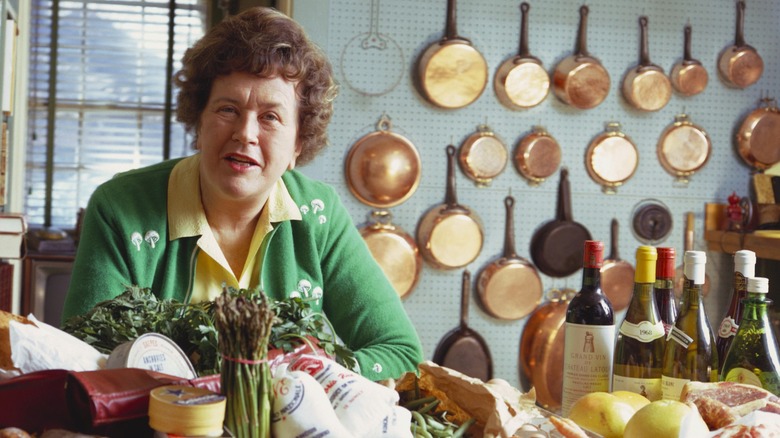Why Julia Child Always Believed In Making Your Own Pasta Dough
Believe it or not, there was a time in American culinary history when we didn't know how to perform a whole lot of techniques that are second nature to home cooks today. When Julia Child's cooking show came along in 1963, the country was feasting on TV dinners and casseroles made with onion soup mix, and they were washing it all down with glasses of Tang. Child changed all that, of course, with her no-nonsense approach to cooking dishes from scratch, especially foods that feel unapproachable like fresh pasta.
In fact, Child believed strongly that it's always best to make your own pasta dough. Homemade pasta might seem intimidating at first, especially when you can buy almost any shape you'd like at the grocery store these days. But no dried pasta will ever be as good as homemade (just ask any Italian), plus, as Child points out, a decent pasta machine pays for itself over time so there's a financial incentive to mastering the art of making fresh pasta.
A batch of fresh pasta is easier (and cheaper) than you think
Although most of us think of a cardboard box with a little plastic window when we think of pasta, the truth is that store-bought dried pasta is an incredibly modern invention. People have been eating pasta since the 4th century B.C., which was quite a long time before supermarkets and convenience foods were invented. Basic pasta dough is made with only a few simple ingredients, typically just flour, eggs, and a pinch of salt. If you can't eat eggs, or don't have any on hand, you can even make it with just flour and water.
The part of pasta-making that freaks people out seems to come with the kneading, rolling, and shaping part of the process, which is why a good pasta machine is literally worth its weight in gemelli. According to Julia Child, if you make enough pasta at home you can justify the cost of buying one. In a 1980 episode of her show, she did the math and found out that she covered the cost of a $30 pasta machine after making around 140 batches of fresh pasta versus buying pasta from the store. "It's half as much if you make it yourself, and it's twice or three times as good," she said on the show "Over Easy" (via KQED on YouTube).
A pasta machine is nice, but not necessary
The cost of living has, of course, increased since Julia Child bought her pasta machine in the 1980s, but believe it or not, you can still get a decent hand-crank pasta machine for around $30. If you want to spend more on extra bells and whistles, there are more expensive models, but a basic machine should not cost more than $100. Not only that, pasta machines are items that show up regularly at garage sales and thrift stores, so you can get a used one super cheap. With that said, just like boxed pasta, pasta machines are relatively new inventions.
People have been making fresh pasta with their own two hands and a rolling pin for centuries. Once you have the dough made, all you need is enough patience to roll the dough out until it's thin enough to see your hand through it. It might take a little longer than a pasta machine, and the strips of pasta may not be as uniform, but it will taste amazing in your next batch of pappardelle alla boscaiola, or however you decide to cook your fresh pasta. Just keep Child's cooking philosophy in mind: "You don't have to cook fancy or complicated masterpieces — just good food from fresh ingredients."


